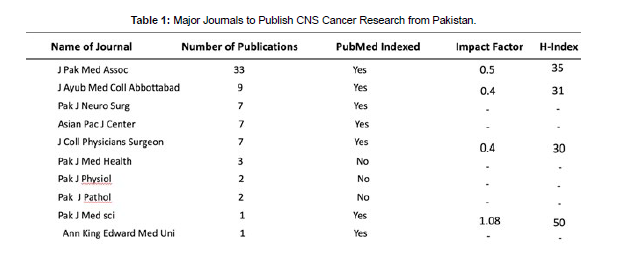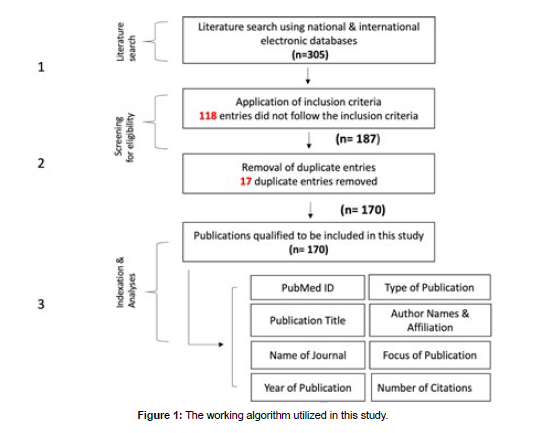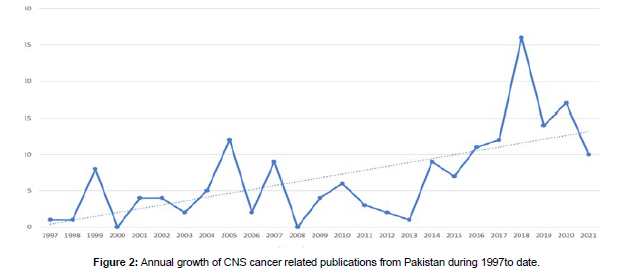Quantitative analyses of central nervous tumours in Pakistan
Received: 02-Jun-2024 / Manuscript No. jpcm-24-134181 / Editor assigned: 04-Jun-2024 / PreQC No. jpcm-24-134181 / Reviewed: 18-Jun-2024 / QC No. jpcm-24-134181 / Revised: 22-Jun-2024 / Manuscript No. jpcm-24-134181 / Published Date: 28-Jun-2024
Abstract
Objective: To systematically investigate the status of CNS cancer research in Pakistan.
Methods: Local (PakMedinet) as well as international (PubMed, ISI WoK) were deep-mined using keywords covering various types of malignant CNS tumours. Publications were extracted. An in-house built pipeline of data filtration was applied to obtain relevant studies for further analyses. Data were analyzed using SPSS and/or PRISM. Descriptive statistics including percentages, frequencies were reported.
Results: Of the 305 total researches retrieved initially, a total of 170 fulfilled the inclusion criteria pipeline. Of these 170 publications, 120 were original articles, 27 were review articles, 18 were case reports and 5 were other publication categories. Cumulative citations received by these 170 publications were 1295. The latest article of CNS cancer was published in 2021, suggesting active research in this area from Pakistan. A total of 81 publications were published in international journals while 89 were publications in Pakistani journals. Overall, the highest number of publications were published in the J Pak Med Assoc, followed by J. Ayub Med. Coll. Abbottabad, and then by Pak J Neuro Surg. The highest number of publications was published from the Aga Khan University, Karachi, followed by Ayub Medical College Abbottabad and University of the Punjab, Lahore.
Conclusion: Taken together, this is the first report detailing status of CNS cancer research in Pakistan. While there are a good number of publications available addressing CNS cancers in Pakistan, these tumours must be investigated further as their incidence, prevalence and associated mortality are on rise in the country.
Keywords
Cancer epidemiology; Cancer registry; Cancer research; CNS tumours
Introduction
Central nervous tumors (CNS tumors) are a major contributor to the global cancer-related morbidity and mortality, causing 2.7% of cancer deaths, with a higher incidence in males as compared to females. Remarkably, both incidence and mortality rates of primary tumors are higher in developed countries than in developing countries9.Studies, particularly in Western countries, have indicated an increasing occurrence of CNS cancers, most notably among the elderly population3. In the USA, the incidence of primary brain tumors is roughly 14.8/100,000/year, while the mortality rate is 5.6/100,000 and 3.7/100,000 for males and females, respectively9. Pakistan, a low-income country, is the fifth most populated country in the world4.CNS tumors are the 13th most frequently diagnosed tumors in Pakistan 2, with approximately 3.6% diagnosed as malignant, and they are the 8th most frequent cause of cancer related mortality9;2. Aetiopathogenesis of CNS tumours are not well understood. Main risk factors include genetic factors, ionizing radiation, viral infections, hormonal contraceptives, statins, and alcohol, but no definite conclusions can be taken3.There are some data to suggest that CNS tumors may be a consequence of workplace, dietary, and other personal or residential exposures, but studies of cell phone use and electromagnetic fields were inconclusive in tying its use as a cause of CNS tumors5. Central nervous system tumors feature more than 100 histological subtypes according to the revised 4th edition of WHO’s 2016 classification of CNS neoplasms. Gliomas are the most common primary CNS tumors, responsible for an estimated 24.7% of all primary tumors and 74.6% of all malignant tumors. Other histologically distinct tumors consist of ependymomas, schwannomas, medulloblastomas, CNS lymphomas, and meningiomas 2. Unfortunately, in Pakistan, the collection of epidemiological data is tricky due to a lack of a centralized cancer registry system and data collection system 2. In this study, we aimed to systematically investigate the status of CNS cancer research in Pakistan. We have recently reported the continuous rise of central nervous system tumors in Pakistan. It, therefore, becomes highly relevant to investigate if CNS tumors are being appropriately investigated by Pakistani researchers. While there are considerable research papers being published from the country, the tumor type must be addressed more aggressively due to its high incidence, prevalence, and mortality in Pakistan. Moreover, the study presented herein has, for the first time, quantitatively investigated the status of CNS tumour research in Pakistan. We recommend continuity of such studies so that the status of CNS tumour research may be monitored appropriately to give relevant data to policy makers.
Methods
This observational review was directed at Dow International Medical College of Karachi utilizing a three-part strategy: (1) literature search, (2) screening of publications using a strict inclusion criterion for eligibility, (3) indexation and analysis. All duplicates were prohibited from investigations. CNS tumor in Pakistan was our primary base for discussion on publication in Pakistan. The three part strategy is described below.
Literature Search
This was performed by four authors. In order to extract central nervous tumors related research in Pakistan (PakMedinet) as well as in international (PubMed, IsI WoK) journals, electronic scientific data analysis was explored. To expand this literature search, a major variety of keywords such as: “Astrocytoma and Pakistan”, “Ependymoma and Pakistan”, “Glioblastoma and Pakistan”, “Medulloblastoma and Pakistan” and “Oligodendroma and Pakistan” were entered. Information mining was additionally fortified utilizing the web search GOOGLE and GOOGLE SCHOLAR with a limitation to only show the website pages that were related to central nervous tumors in Pakistan6.
Screening Of Publication for Eligilibity:
In order to identify publications of interest (to be analyzed in our study), after removal of all duplicate publications, a strict inclusion criterion was specified. Only those publications were included for the study where [1] central nervous tumor was the primary focal point of distribution either straightforwardly, or if there should arise of occurrence in epidemiological studies, gave significant data in regarding to central nervous tumor predicaments in Pakistan, [2] research was attempted in Pakistan or was directly tending to central nervous tumor in Pakistan and additionally, [3] the main author was affiliated to a Pakistani institution. All entries (with and without accessible full texts) satisfying the previously mentioned criteria rules were remembered for the last analyses [8].
Indexation and Analysis:
Four authors indexed the data in Microsoft Excel individually to avoid any errors. As stated earlier, several data points from each publication were recorded for their: PubMed ID, title, name of journal, year/types of publications, authors name, affiliations, institutes focus on major and minor criteria. Publications which were not filed in PubMed were recalled for non-indexed publications6.Ultimately, information entered by the four authors was analyzed further, and any irregularities were explored and looked to produce consensus indexation. Consensus data was then at that point gone into SPSS for additional spellbinding investigations, such as estimation of frequencies and percentages [4].
Results
Initially, a total of 305 studies were retrieved. Of these, 118 entries did not meet the inclusion criteria, and were removed from the study leaving a total of the 187 to be further analyzed. Of the 187 studies, 17 were duplicate entries, so were removed as well. The remaining 170 entries were subjected to final analyses described in this study.
Annual growth of publications
The first and last article on central nervous tumors from Pakistan were published in 1997 and 2021 respectively. Overall, a total of only 10 (5.9%) publications were published before the year 2000. During 2000-2005, a total of 27 publications were published while a total of 21 publications were published during 2006-2010. Within the next five years, 2011-2015, a total of 22 publications were published Since 2016 to date, a total of 90 publications were published with 2018 being the year with the highest number of published articles (n=26) [5, 6]. Since 1997 to date, the average number of publications per year has been low, with only 6.8 publications per year.
Types and research foci of publications
Of the 170 publications that we investigated, a total of 81 (47.6%) publications were indexed in PubMed while F89 (52.4%) were non-indexed publications. Main journals which published central nervous tumors from Pakistan are represented in (Table 1) (journals with more than 1 publication are listed only). Of the 170 publications, 120 (70.6%) were original research publications, 27 (15.9%) were review articles, 18 (10.6%) were case reports and 5 (2.9%) were categorized as others or in an undefined category [7].
Author affiliations and contributing institutions
A total of 55 Pakistani institutions/research centers contributed to the publications that were investigated in this study. Of these, a total of 37 were public/government sector while 17 were private institutions and 1 was semi-private. Interestingly, these 55 institutions were only from 14 cities of Pakistan with Lahore being the main contributor (n=16). These analyses revealed that most cities of Pakistan have no contribution in the field of central nervous tumor. Major contributing institutions towards the publications are listed in (Table 2). Number of citations received Of 170 articles, a total of 35.9% (n=61) articles did not receive any citation [8, 9]. The remaining 109 articles were cited minimum one time and therefore summed up to a total of 1295 citations. Of these, 72.8% (n=943) belonged to original articles, 21.6% (n=280) belonged to review articles, 3.6% (n=46) belonged to case reports, and the remaining 2% belonged to all other types of research (Figure 1).
Discussion
There has been substantial increase in CNS tumours in various cities of Pakistan as reported by mainstream cancer epidemiological bodies of the country including the Punjab Cancer Registry 1, the Dow Cancer Registry8 as well as from the Karachi Cancer Registry4. It is therefore very important to investigate Pakistani researchers are appropriately investigating these tumours or not. The current study is first ever systematic approach to investigate existing status of CNS cancer research in Pakistan (Figure 2).
Overall, our data highlight notable increase in CNS cancer research after the year 2000 which is concordant with the increasing incidence and prevalence of these tumous in the country in recent years. While the average number of publications per year is only 6.8 papers/year, it must be noted that there is an upstroke in number of papers published in recent years indicating that Pakistan researchers have taken up on investigating these tumours as their numbers rise in the country. This is in contrast to status of esophageal and skin cancer research as reported by our groups previously 8; 6 It is encouraging to note that approximately 70% of the publications were original research articles. This indicates that CNS cancer research is a prime focus of Pakistani researchers and they are aiming to publish more of original data with high novelty quotient [9].
While a good number of Pakistani institutes (a total of 55) participated in CNS cancer research presented in our study, it is important to note that these are representative of only 14 cities of Pakistan. It is therefore highly encouraged that more cities (and institutes) invest their resources towards investigating CNS cancers in Pakistan.
A sign of concern however is the fact that almost 50% of the publications did not publish in impact factor journals and therefore were not rated as high impact papers. Perhaps for this reason, considerable publications did not receive any citation to date indicating their invisibility/importance to relevant readers/researchers. It is important that Pakistani researchers publish their research in indexed journals so that the research is easily visible to international/relevant audience. Taken together, to the best of our knowledge, this is the first study investigating pan-Pakistan status of CNS cancer research. Our findings have not only highlighted current status of CNS cancer research in the country but also provide considerable insights in future directions to address this increasingly prevalent tumour type in Pakistan. We recommend to the policy makers to allocate appropriate funds and resources to address CNS cancer research in Pakistan.
References
- BadarF, MahmoudS (2021) Cancer in Lahore, Pakistan, 2010–2019: an incidence study. BMJ Open 11: 47-49.
- Danish F, Salam H, Qureshi MA, Nouman M (2021) Comparative clinical and epidemiological study of central nervous system tumors in Pakistan and global database. Interdisciplinary Neurosurgery 1: 101239.
- Miranda-Filho A, Piñeros M, Soerjomataram I, Deltour I, Bray F, et al. (2017) Cancers of the brain and CNS: global patterns and trends in incidence. Neuro-oncology 19: 270-80.
- Pervez S, Jabbar AA, Haider G, Ashraf S, Qureshi MA, et al. (2020) Karachi Cancer Registry (KCR): Age-standardized incidence rate by age-group and gender in a Mega city of Pakistan. Asian Pacific journal of cancer prevention: APJCP 21: 3251.
- Wrench M, Minn Y, Chew T, Bondy M, Berger MS, et al. (2002) Epidemiology of primary brain tumors: current concepts and review of the literature. Neuro-oncology 4: 278-99.
- Rehman SH, Majid B, Syed SA, Qureshi MA (2021) Quantitative Analyses of Skin Cancer Research in Pakistan. Pakistan Journal of Medical Sciences37: 582.
- Qureshi MA, Khan S, Ujjan ID, Iqbal A, Khan R, et al. (2016) Quantitative analyses of esophageal cancer research in Pakistan. Asian Pacific Journal of Cancer Prevention17: 3117-22.
- Qureshi MA, Khan S, Sharafat S, Quraishy MS (2020) Common Cancers in Karachi, Pakistan: 2010-2019 Cancer Data from the Dow Cancer Registry.Pak J MedSci 36: 1572-1578.
- Zahid N, Martins RS, Zahid W, Khalid W, Azam I, et al. (2021) Resilience and its associated factors in brain tumor patients in Karachi, Pakistan: An analytical cross‐sectional study. Psycho‐Oncology30: 882-91.
Indexed at, Google Scholar, Crossref
Indexed at, Google Scholar, Crossref
Indexed at, Google Scholar, Crossref
Indexed at, Google Scholar, Crossref
Indexed at, Google Scholar, Crossref
Indexed at, Google Scholar, Crossref
Citation: Ghania K, Aaqib A, Izat U, Urooba K, Maheen S, Ghousia A, Kinzah I,Fasiha M, Osama MS, Omama H (2024) Quantitative Analyses of Central NervousTumours in Pakistan. J Palliat Care Med 14: 632.
Copyright: © 2024 Omama H, et al. This is an open-access article distributed underthe terms of the Creative Commons Attribution License, which permits unrestricteduse, distribution, and reproduction in any medium, provided the original author andsource are credited.
Share This Article
Recommended Conferences
42nd Global Conference on Nursing Care & Patient Safety
Toronto, CanadaRecommended Journals
Open Access Journals
Article Usage
- Total views: 494
- [From(publication date): 0-2024 - Apr 06, 2025]
- Breakdown by view type
- HTML page views: 313
- PDF downloads: 181




